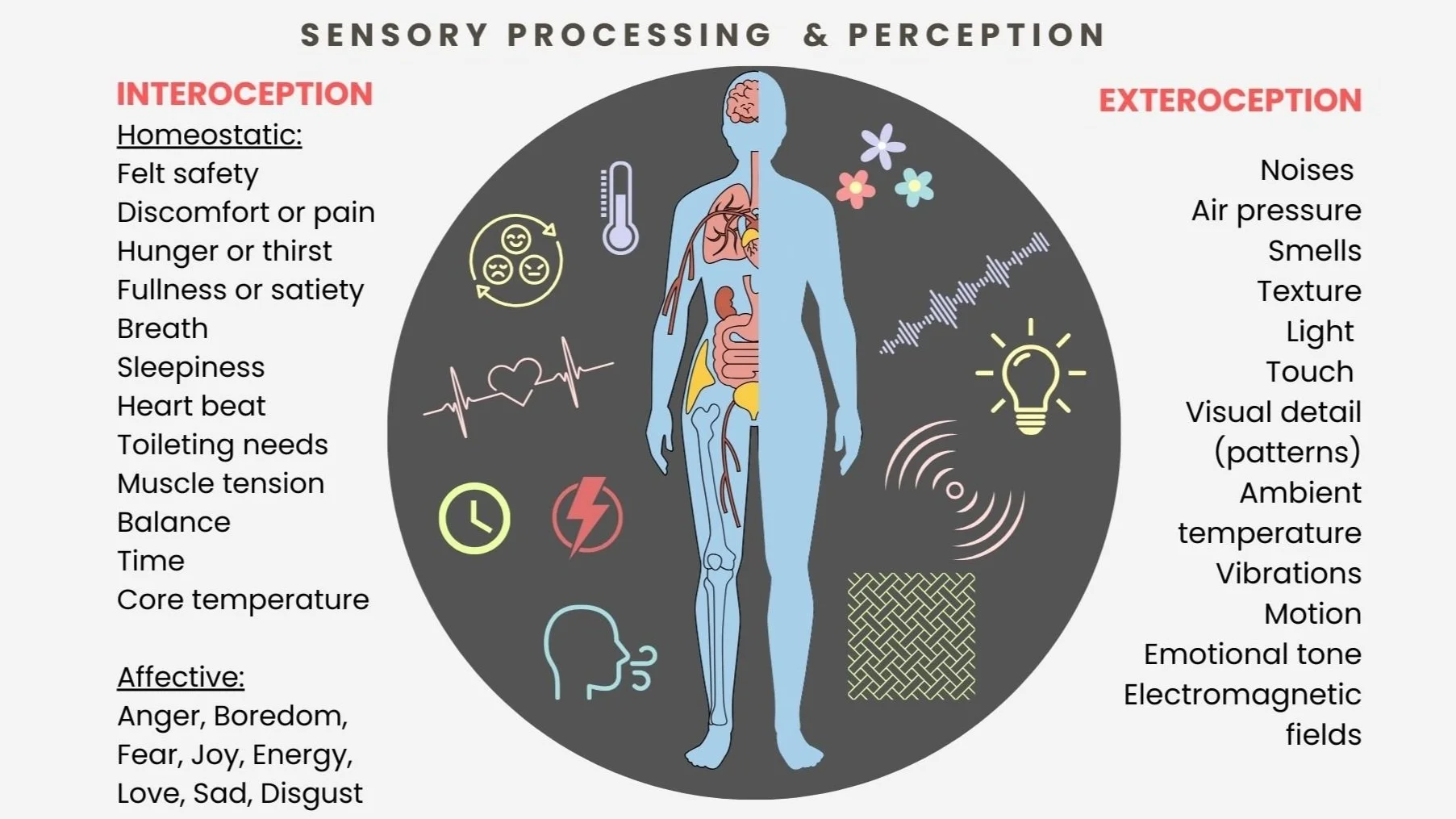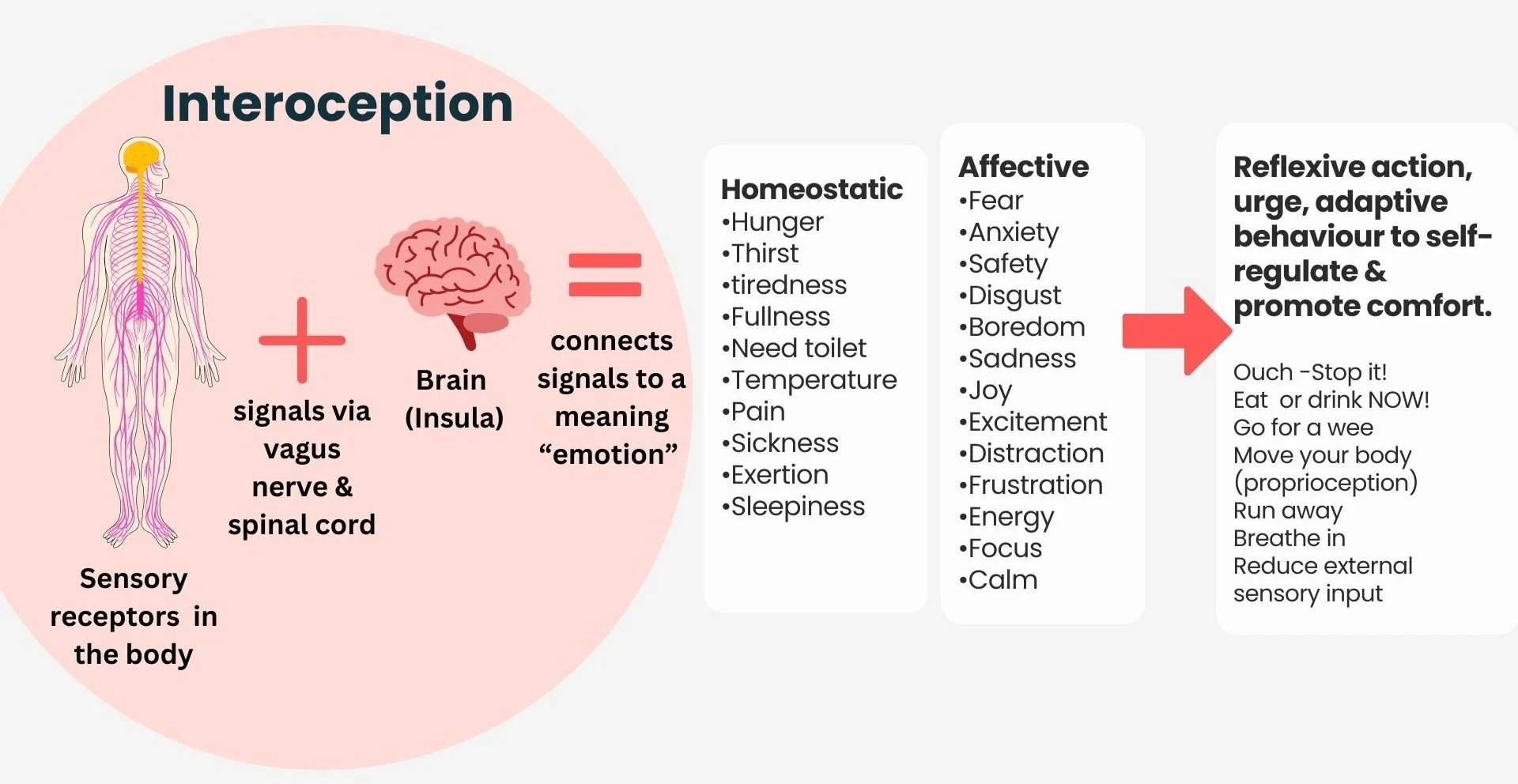Part 1: Interoception, Sensory Processing and Mental health
When it comes to our senses we tend to think of the well known senses: touch, smell, taste, sight and sound. These days there are over 25 recognised senses and depending on your definition of senses up to 1000!
How we each perceive, interpret, integrate and react to sensory information is completely unique and valid.
Some people are highly sensitive or hyper aroused, whereas others might have muted sensation and hypo-aroused - and this can be innately wired, or initiated by something else like burnout or trauma.
You can also be hyper aroused to some types of sensory input and hypoaroused to others - this mixed pattern is common in neurodivergent people.
The mixing desk analogy is a great way to describe my clients’ unique sensory preferences, because there is no right or wrong way to feel.
Your sensory preferences are also determined by several things:
Intensity - for example some people liking a mild spice, but not an intense spice.
Novelty – some people prefer predictability and routine and novel sensory input (or change) can be hyperarousing for them. An example could be your driving route to work being diverted and suddenly having to navigate a different area and this unpredictability and change can be overwhelming. Other people like novelty and anything too that is too predictable is not arousing enough to their nervous system and that can make them irritable and restless.
Complexity - If we think of how this might relate to food choices, some people have a preference for plain textures or tastes or colours. Like plain chips, pasta or crunchy things and over-complicated tastes, textures, colours and smells can be can be a form of sensory overload. You might find it interesting to know that we also have taste buds beyond the mouth and tongue - they are dotted throughout our GI tract… there are even bitter taste buds in the lung and upper airways detecting information there!
This demonstrates that everything that we ingest or enters the body is a source of information… and just like a computer, we can experience information overload.
These three things combine together to create our sensory preferences, and like with the mixing desk – the volume of this sensory input can change depending on your mental state… things can seem louder if you are more burnt out or hypervigilent!
People can have difficulties with processing, sensory overload, disconnection or perceptual differences like synesthesia.
incoming sensory information can be from the outside world (referred to as exteroception) or from within our own body (referred to as interoception) and all this information has to be processed by our brain which assigns meaning to them. Up to 16.5% of people have a sensory processing disorder but this figure is thought to be much higher in neurodivergent people.
People can experience sensory overload (from excessive information entering their brain, and the inability to filter out all the data) or they can also can have a muted perception of input or synesthesia where stimulating one sensory or cognitive pathway can lead to a felt sensation in another pathway such as perceiving colours when you think about numbers or words.
What is interoception?
Interoception is our 8th sense and we have receptors throughout our bodies… in our brain, in the bladder, gut, uterus, muscles and heart. These receptors are continuously gathering information about what’s going on in your body and sends this information primarily through the vagus nerve and spinal cord to your brain where many different areas are involved in processing this data, especially a part of the brain called the Insula.
The insula uses these incoming messages to figure out what our body needs in that moment.
It could be an emotion we are experiencing or it could indicate that something physical is out of balance like our blood glucose or body temperature that we need to act upon - and the brain will promote a reflexive urge or action to regulate ourselves (this is what we refer to as homeostasis).
We don’t really talk about emotions as a sensory system but they are. Much the same as sensory hyper or hypoarousal, neurodivergent people are particularly prone to the impacts of heightened emotional sensitivity such as with Rejection Sensitivity Dysphoria, or dampened emotional sensitivity such as with Alexithymia (which we will discuss in part 2).
Processing all this information is a complex task! For example the receptors in our gut could be sending up information that it feels empty and nauseous (stomach rumbles) which could be interpreted as feeling hungry and needing to eat, but also could be interpreted as anxiety or dread…
Sensations mean different things for individuals, and as practitioners we are trained on what signs and symptoms indicate in neurotypical people, but not neurodivergent people with perceptual differences. So we can unintentionally invalidate people’s true feelings of discomfort, pain or distress if we impose our own interpretations on what these sensations mean.
Good interoceptive awareness means we are able to accurately identify what is happening inside our body.
Research is showing that interoception differences are connected to a large list of mental health and psychiatric diagnoses ranging from eating disorders to fibromyalgia.
Central to this research is the insular cortex, a part of our brain which plays a vital role in pain perception, appetite, emotions (such as happiness, anger and disgust), body awareness (such as temperature and heart rate) and how we perceive our sense of self
Decreased insula functioning is associated with statistically higher rates of:
Anxiety & Depression
Eating disorders
PTSD
Self harm
Substance addictions
OCD, Tourettes and Tic-disorders
Chronic pain and Fibromyalgia
in part because it results in a difficulties recognising our body signals, meeting our physiological needs or regulating our emotions.
In part 2 we will discuss Alexithymia and Aphantasia - two traits that strongly impact sensory perception and mental health.



